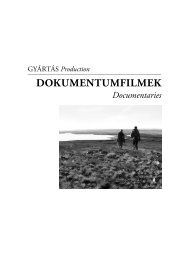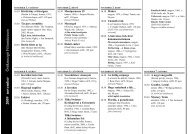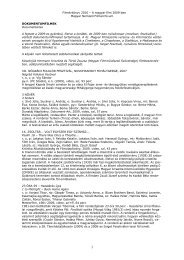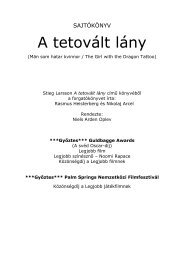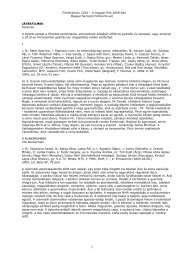Részletes program (pdf)
Részletes program (pdf)
Részletes program (pdf)
Create successful ePaper yourself
Turn your PDF publications into a flip-book with our unique Google optimized e-Paper software.
emains ambiguous all the time, as well as the relationship of the “lovers”…By resorting to stupefying, absurd solutions, João César Monteiro dividesthe public and the critics. His works either meet absolute incomprehension(saying, it can’t be called a film if for half an hour there is nothing to be seenbut people eating in a noisy room), or they are found wittily entertaining,particularly due to their saucy-spicy dialogs. However it may be, in 1989 thisfilm was awarded the Silver Lion at the Venice Film Festival.21-én fél 9-kor/on 21 Sept., at 8.30 p.m.Trás-os-montesTrás-os-montesAntónio Reis, Margarida Martins Cordeiro, 1976» A rendező házaspár Észak-Portugália legeldugottabb csücskébe kalauzol.A film a leszakadás és a bezárkózás, az autark élet gyönyörű képekkelmegalkotott vizuális metaforája. Falusi életképeket elevenít meg az ittélőkből alakult két amatőr színjátszó csoport, a Brança és a Miranda doOuro segítségével. A portugál történelem és a népi hagyományok együttélnek a kis vidéken. Az emigrációba kényszerültek miatt szétforgácsolódottcsaládokat ismerhetünk meg, és leveleket olvasnak fel nekünk, melyek révénbeleképzelhetjük magunkat a családok mindennapjaiba.» The directors of the film, a married couple, guide us into the remotestcorner in the North of Portugal. Featuring gorgeous images, the film isa visual metaphor of dropping-out and seclusion, of autarchic life. Villagescenes spring up with the help of Brança and Miranda do Ouro, two amateurtheatre groups made up of those living here. Portuguese history and folktraditions live together in this tiny neighborhood. We are shown familiesbroken up due to the departure of those forced into emigration, and we areread letters making us imagine the daily life of the families.23-án fél 9-kor/on 23 Sept., at 8.30 p.m.elmosódik a határ közöttük. A filmet időnként szkeccsmorzsák törik meg.Például vissza-visszatérő vicces jelenet egy részeges helybéliről, aki mindigmegpróbálja alávetni magát a vidék kis kőhídjáról.» Situated in the hills, Arganil is one of the popular summer haunts of thePortuguese. Yet relaxation, recreation is not the same experience for thePortuguese visiting this place as might be concluded from the photos in themagazines of the travel agencies. Instead, they play havoc with the peacefulneighborhood. They sing karaoke, dance, booze, and carouse. The inhabitantsadapt to them. There is also a film staff hanging around. The director and theproducer talk about a screenplay by which they might have made a feature film,but there hasn’t even been a casting. For want of something better, they filmwhat is going on. They record documents. A local girl wants to play in theirfilm. Then the members of the band playing the music for the party seem tobring forth the story which the filmmakers have previously been talking about.15-year-old Tania, the singer, and her cousin fall in love, but it also appearsthat between Tania’s father, the leader of the band, and his daughter theremight be something beyond the relationship of father and daughter. That is,a love triangle evolves. Fictional and documentary elements alternate, until theborderline is blurred between them. From time to time, the film is interruptedby crumbs of sketches. For example, by the funny scene of a local drunkard, whotries again and again to jump from his endeared stone bridge.30-án 6-kor/on 30 Sept., at 6.00 p.m.Portugál búcsúUm adeus portuguêsJoão Botelho, 1985» Egy szakasz katona lépdel az őserdőben valahol egy portugál gyarmaton.Akna robban. Az egyikük meghal, a többiek szétszóródnak az erdőben,és lövöldözni kezdnek. A fim kezdő képei az értelmetlen gyarmati harcotszimbolizálják. Aztán tíz évvel későbbre ugrunk az időben. A Minto-vidékenElmúlt fiatalságJuventude em marchaPedro Costa, 2006» Lisszabon egyik külvárosa, Fontainhas a zöld-foki-szigeteki bevándorlókáltal lakott rész. A nyomorúságos negyedet lebontják, az ott élőket (csaknemkilencezer embert) átköltöztetik egy olcsó bérű, új építésű lakótoronyba CasalBobába. Ventura már túl van a hetvenen, több mint harminc évet húzottle barlangszerű lakásában a feleségével, Clotildéval. A békés öregasszonymost összeomlik: ha menni kell, akkor ő inkább visszaköltözik a Zöldfoki-szigetekre.Hogy nyomatékot adjon elképzelésének, törni-zúzni kezd.Közben az öreg egy utolsó barangolásra indul a negyedben. Miközbenbemutatja nekünk a fiatalokat, az életét is elmondja. Megtudjuk, hogyegykor az építkezések nyújtotta munkalehetőség vonzotta a fővárosba, aztánbalesetet szenvedett…két idős földműves felkerekedik, hogy Lisszabonban meglátogassák kisebbikfiukat és az afrikai háborúban elpusztult fiuk özvegyét, Laurát. Ám a nőnekúj kapcsolata van, Alexandrét pedig teljesen magába szippantotta a nagyváros. A halott katona emléke egyre halványul. Már nem képes összetartania családot. A nagyvárosban a fiatalok élete lüktet tovább, de az idős párnaknincs helye többé ebben a világban…» A platoon of Portuguese soldiers strides in the jungle, somewhere ina Portuguese colony. A mine explodes. One of them dies; the others dispersein the forest and start shooting. The first sequences of the film symbolize thesenselessness of colonial warfare. Then there is a skip of ten years. A couple ofold farmers in the Minto area set out for Lisbon to visit their younger son andLaura, the widow of their son killed in the African war. But the woman hasa new partner, while Alexandre has been fully assimilated by the metropolis.The dead soldier’s memory is fading ever more. It is no more able to keepthe family together. The young people’s life rushes on in the bustle of themetropolis, but for the old couple there is no place in this world anymore…30-án fél 9-kor/on 30 Sept., at 8.30 p.m.» Fontainhas, one of the suburbs of Lisbon, is inhabited by immigrants fromthe islands of Cape Verde. The slum is to be pulled down, those living there(nearly nine thousand people) are to be removed to a newly built low-renttower block in Casal Boba. Ventura, 70+, and his wife Clotilde have stayedout more than thirty years in their cave-like flat. The placid old woman breaksdown: if she has to go, she will rather move back to Cape Verde. In order togive emphasis to her idea, she goes on a rampage. Meanwhile her old manmakes for a last walk in the district. While introducing the young people tous, he also tells his story. We learn that once he was attracted to the capitalby the new jobs provided by construction works, and that then he had anaccident…28-án 8-kor/on 28 Sept., at 8.00 p.m.Az a kedves augusztusi hónapAquele Querido Mês de AgostoMiguel Gomes, 2008» A portugálok egyik kedvelt nyaralóhelye a hegyvidéki Arganil. Ám a lazítás,a kikapcsolódás az ide látogató luzitánok számára nem olyasféle időtöltés,mint amit az utazási irodák magazinjainak fotói sejtetni engednek. Feldúljáka csendes környéket. Karaokéznak, táncolnak, vedelnek, mulatoznak.A helybéliek is alkalmazkodnak hozzájuk. Egy filmes stáb is itt bolyongközöttük. A rendező és a producer egy forgatókönyvről beszélnek, amibőlnagy filmet készíthettek volna, de még a szereplőválogatásig sem jutottak.Jobb híján forgatgatnak. Dokumentálnak. Egy helybéli lány szeretnebelekerülni a filmjükbe. Aztán a mulatsághoz zenét szolgáltató együttestagjai között mintha elkezdődne az a történet, melyről a filmesek beszéltekkorábban. A 15 éves énekes lány, Tania és az unokatestvére között szerelemszövődik, de az is felsejlik, hogy az együttes vezetője, Tania apja ésa lánya között sem csupán apa-lánya viszony van. Vagyis adott egyszerelmi háromszög. Fikciós és dokumentumelemek váltakoznak, mígnemTiago Baptista, a Cinemateca Portuguesa– Museu do cinema történészének előadásaa portugál filmtörténetrőlLecture of Tiago Baptista, historian ofCinemateca Portuguesa – Museu do cinema,about the history of Portuguese film» A „portugál mozi” látszólag egyértelmű és tisztán földrajzi vagy kulturálisfogalom, pedig ez egy ideológiailag terhelt meghatározás. Ennek fényében kellnézni, hogy milyen portugál filmek születtek (vagy éppenséggel nem születhettek)az elmúlt évszázad során. Előadásomban ennek a helyzetnek a keletkezését éskülönféle megjelenési formáit fogom elemezni. Meggyőződésem, hogy ebbőlfakadhat, hogy a portugál filmek hol hagyták magukat befalaztatni a „nemzet”esszencialista felfogásán alapuló identitás gettójába, hol eleve reménytelenversenyfutásba kezdtek a külföldi szórakoztató filmekkel. Végül begyűrűzöttkülföldről a „szerzői” film, mely, dicséretére legyen mondva, lehetővé tette ugyanjó néhány eredeti film létrejöttét, ám azzal fenyegetett, hogy a teljes nemzetifilmművészet bolondériává vagy netán műfajjá szűkül.» A seemingly transparent and merely geographical or cultural notion,‘Portuguese cinema’ is actually an ideologically charged concept thatdetermined most of what Portuguese films became (and were not allow tobecome) over the past century. This lecture will interrogate that concept, itsformation and different configurations over time. I believe the ambivalence ofthe concept to be responsible for the way Portuguese films allowed themselvesto be walled inside the ghetto of an identity founded upon an essentialist viewof the 'nation', an impossible desire to compete with foreign entertainmentcinema, and finally, an ‘autheurism’ assembled from abroad which, at the sametime as it praised the originality of a handful of films, threatened to reduce anentire national cinematography to a fad, or even to a genre.20-án fél 7-kor/On 20 Sept., at 6.30 p.m.



